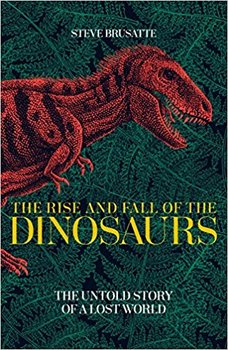
Yes, dinosaurs live today. You’ll learn a lot in this lively personal account by a passionate paleontologist.
Quick: how many different species of dinosaurs can you name?
T. rex, of course. Brontosaurus. Triceratops, maybe. Velociraptor, of Jurassic Park fame. Possibly also Pterodactyl (correct name: Pterosaur). If you’re really well informed, you might cite several others.
But would you believe that hundreds of dinosaur species have already been discovered—and a new one is discovered on average once a week?
Still, on reflection, why should you—or I—be surprised at that? After all, dinosaurs roamed the Earth for more than 160 million years and reigned as the dominant life-form for more than 130 million (compared to the two million years that we humans have been around). One hundred sixty million years is plenty of time for new species to evolve and for them to cover the planet as surely as we humans have done. “There were probably many billions of dinosaurs spread all over the world,” as paleontologist Steve Brusatte reports in his lively personal account, The Rise and Fall of the Dinosaurs: The Untold Story of a Lost World.
The Rise and Fall of the Dinosaurs: The Untold Story of a Lost World by Steve Brusatte (2018) 416 pages ★★★★★
10,000 dinosaur species live today
In fact, some ten thousand dinosaur species still live on, 66 million years after the dinosaurs were supposedly wiped out. They’re called birds. And yes, they are dinosaurs. Dinosaurs live today! Just because the dinosaurs of yore that we know and love are enormous doesn’t mean they all have to be. In fact, the earliest dinosaur species were about the size of today’s dogs. And even in later times once the biggest beasts had evolved there were dwarf dinosaurs found in isolated locations.
If you Google what I’ve written above, you may get different information. But Steve Brusatte will set you straight. His book is grounded in the latest findings in the field. Old views about dinosaurs are toppling all the time as a new generation of scientists like Brusatte move ahead with their work. If you enjoy reading about science and scientists, you’ll love this book.
Dinosaurs evolved earlier than previously thought
It is generally believed that dinosaurs didn’t evolve until the middle of the Jurassic Period (about halfway through the Mesozoic Era) and lived for some 130 million years. Brusatte reports that, in fact, the first dinosaurs emerged in the Triassic Period (near the beginning of the Mesozoic Era) “some time between 240 million and 230 million years ago.” They lived, then, for some 160-170 million years. For more perspective, check out a terrific infographic online from Oxford University Press that illustrates the evolution of the dinosaurs. It’s here: https://blog.oup.com/2016/04/dinosaurs-timeline-infographic/.

Brusatte’s account introduces us to many of the leading figures in the history of paleontology as well as the younger men and women who are advancing the field with new tools and techniques. Unavoidably, he explains the underlying facts of geology that dictated when and where dinosaurs could live: during the Mesozoic Era, the planetary continent of Pangea slowly broke apart, forming the geography with which we are familiar today. As the supercontinent came apart, dinosaurs became increasingly isolated geographically, and new species evolved that were unique to particular areas. (The most prominent of these examples to our eyes is T. Rex, which was limited to what is today the western portion of North America.)
About the author
Steve Brusatte is a young American paleontologist and evolutionary biologist who specializes in the anatomy and evolution of dinosaurs. He is just 34 at this writing. Brusatte is a Chancellor’s Fellow in Vertebrate Palaentology at the University of Edinburgh. The Rise and Fall of the Dinosaurs is his eighth book. His earlier works include both scholarly studies and popular science as well as a widely acclaimed textbook in his field.
For related reading
You might also enjoy Science explained in 10 excellent popular books.
If you enjoy reading nonfiction in general, you might also enjoy:
- Great biographies I’ve reviewed: my 10 favorites
- My 10 favorite books about business history
- 20 top nonfiction books about history
And you can always find my most popular reviews, and the most recent ones, on the Home Page.


























